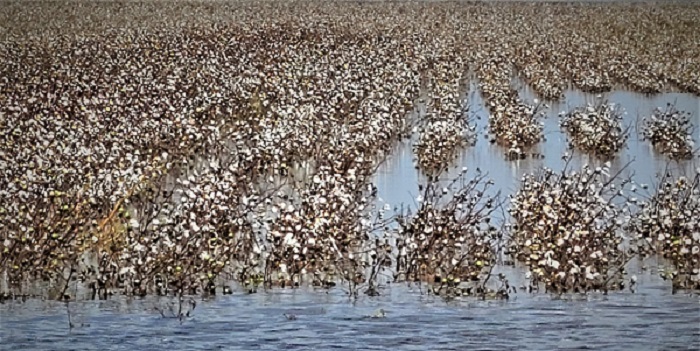By Adam Russell
Cotton producers in the Rio Grande Valley took a devastating hit from Hurricane Hanna, according to a Texas A&M AgriLife Extension Service expert.
Other row crops like corn and sorghum were harvested before the storm arrived, but some alternative crops like sesame and citrus experienced damages as well.
Dr. Holly Davis, AgriLife Extension entomologist in Weslaco, said Hurricane Hanna took an unexpected last-minute turn to hit Cameron, Hidalgo and Willacy counties on July 24. All three counties were hit with heavy rains, including 6-18 inches of rain, sustained winds of 30-40 mph and gusts of 60-plus mph.
Davis said the cotton crop looked good prior to the storm, and expectations were for an average to above-average season for most producers, especially if they had irrigation.
Cotton harvest was just beginning with about 2% harvested before the storm hit. Most fields were defoliated, and cotton bolls were open with a lot of lint exposed, she said.
Davis said initial assessments by AgriLife Extension experts and producers estimate 90-100% cotton crop losses for around 138,000 acres. Some acres remain underwater due to heavy rains this past weekend.
There were also concerns about cotton seed sprout due to the moisture levels, she said.
“What wasn’t flooded, splashing reduced quality to unmarketable levels in mature fields,” she said. “There were some later maturing fields, but those are wait and see. The ground is saturated, and water has nowhere to go, so there is still a lot of standing water in places.
“There are still concerns about various crops,” Davis added. “It’s still early, so we don’t have a complete picture of what we’re dealing with.”
Luckily corn, sorghum and vegetable crop harvests were pretty much complete. Fall crops won’t be planted until late August or early September.
“Even though this storm was just a Category 1, the damages were widespread, even more so than some previous storms like Hurricane Dolly,” she said. “The wind and rain were bad, but the timing couldn’t have been worse for cotton producers.”


